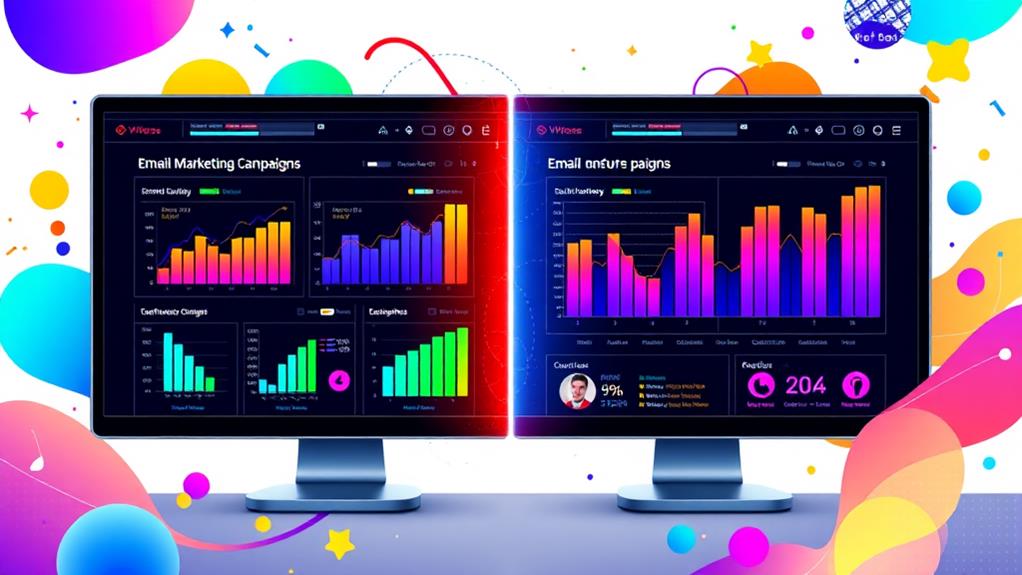Drip campaigns are an essential tool in transforming leads into customers by providing automated, targeted messaging at strategic intervals. These personalized campaigns boast a 47% higher engagement rate and can greatly increase transaction rates. By delivering content tailored to user interactions, such as abandoned cart reminders or welcome series, businesses can both revive inactive customers and enhance customer loyalty. The success of drip campaigns lies in their ability to streamline communication while utilizing data-driven insights for optimization. With platforms like Mailchimp and HubSpot, the potential for revenue growth and improved conversion rates is immense. Discover how these strategies can redefine your customer relationships.
Key Takeaways
- Drip campaigns increase engagement rates by 47% through personalized, timely email sequences, enhancing lead nurturing and conversion.
- Automation in drip campaigns drives 75% of email marketing revenue, improving efficiency and customer retention by 10% to 20%.
- Personalized emails in drip campaigns achieve six times higher transaction rates than non-personalized approaches.
- A/B testing in drip campaigns optimizes subject lines and calls-to-action, potentially boosting conversion rates by 50%.
- Abandoned cart reminders within drip campaigns can recover up to 69% of lost sales, turning leads into customers.
Understanding Drip Campaigns
Drip campaigns, a cornerstone of contemporary email marketing strategies, are automated sequences that deliver meticulously crafted messages at strategically determined intervals, responding to specific user interactions or milestones in their journey.
At their core, drip definitions emphasize the importance of timing and relevance, aiming to nurture prospects through the sales funnel with precision and personalization. These campaigns are carefully architected to align with user behaviors, such as signing up for a newsletter or abandoning a shopping cart, with each touchpoint designed to re-engage or convert leads.
Campaign components in a drip strategy typically include a series of pre-written emails that are triggered by specific actions or events in a recipient's journey.
For instance, a welcome series might greet new subscribers, offering an introduction to your brand and encouraging further exploration. Similarly, cart abandonment reminders gently coax potential buyers back to complete their purchases.
Re-engagement campaigns, on the other hand, aim to revive interest from inactive users, reigniting their connection with timely and relevant content.
Benefits of Drip Campaigns
Drip campaigns markedly enhance engagement rates, with subscribers showing 47% more engagement compared to traditional email blasts.
This heightened interaction translates directly into increased revenue, as personalized drip emails not only foster loyalty but also achieve transaction rates six times higher than non-personalized approaches.
Boosting Engagement Rates
In today's competitive digital landscape, the strategic implementation of drip campaigns has become an essential tool for marketers aiming to boost engagement rates. By leveraging sophisticated engagement tactics and audience segmentation, drip campaigns guarantee that marketing efforts are both targeted and effective. They require approximately eight touchpoints to convert prospects into customers, maintaining consistent communication throughout the customer journey.
This approach not only keeps potential customers engaged but also nurtures leads by delivering timely, relevant content.
Personalized email content stands out as a crucial factor in enhancing engagement. When messages are tailored to the interests and needs of the audience, open rates can increase by up to 26%. This personalization fosters a strong connection between the brand and the consumer, making them more receptive to the marketing message.
Furthermore, automated emails, which account for nearly 75% of email marketing revenue, are instrumental in sustaining customer interest and driving sales.
Drip campaigns also play an important role in reducing customer churn by keeping subscribers informed and involved. This regular engagement fosters long-term relationships and loyalty, ultimately improving conversion rates by up to 50%.
Revenue Growth Potential
Building on the ability of drip campaigns to enhance engagement rates, their impact on revenue growth potential is equally compelling. Automated emails from drip campaigns contribute to approximately 75% of email marketing revenue, a substantial boost to overall sales performance. By implementing personalized drip campaigns, businesses can achieve up to a 50% increase in conversion rates, as tailored messages effectively resonate with segmented audiences. This strategic approach not only enhances immediate sales but also lays a foundation for more precise revenue forecasting.
Moreover, drip campaigns notably bolster customer retention, with businesses observing a 10% to 20% improvement. This retention fosters long-term relationships, encouraging repeat purchases and sustained revenue streams. Regular engagement through drip campaigns also yields a 6 to 8 times higher response rate compared to traditional methods, highlighting their superior effectiveness in maintaining customer interest and driving sales.
From a revenue segmentation perspective, companies that utilize drip marketing strategies report an impressive 18% increase in revenue per email sent. This targeted communication maximizes returns on investment, allowing companies to better allocate resources and refine marketing strategies.
Effective Drip Campaign Strategies
Crafting high-impact drip campaign strategies requires a blend of precision planning and strategic execution. By understanding your target audience and meticulously organizing a content calendar, you can guarantee each email within your drip campaign is purposeful and aligns with your marketing objectives.
Whether aiming for lead generation or re-engagement, clarity in your goals will guide the structure and timing of your communications, thereby optimizing each step of the buyer's journey.
Personalization stands at the forefront of effective drip campaigns. Tailoring content using recipient data can considerably raise engagement levels, with open rates potentially increasing by 29% and click-through rates by 41%. This personalized touch makes your message more relevant and appealing to each recipient, fostering a deeper connection.
Moreover, integrating A/B testing into your strategy can improve performance. By experimenting with different subject lines or call-to-action buttons, you can refine your approach, with optimized campaigns seeing conversion rate boosts of up to 50%.
Consistent timing, such as sending emails at regular intervals, can further enhance audience engagement by 22%. Additionally, incorporating multimedia content like videos can remarkably boost click-through rates by up to 300%, making your message more dynamic and compelling.
Use Cases for Drip Campaigns
Drip campaigns serve as powerful marketing tools designed to systematically engage and nurture your audience through targeted communications. By leveraging lead nurturing and customer segmentation, these campaigns can remarkably enhance marketing effectiveness and conversion rates.
Here are some compelling use cases for drip campaigns that demonstrate their versatility and impact:
- Welcome Series: Implementing a welcome series introduces new subscribers to your brand. When done effectively, it can boost engagement rates by up to 33%, setting the stage for a positive customer journey.
- Abandoned Cart Reminders: Targeting customers who abandon their shopping carts can recover up to 69% of lost sales. These reminders effectively nudge potential buyers back to complete their transactions, enhancing conversion rates.
- Nurture Campaigns: Providing educational content over time fosters trust and positions your brand as an industry authority. This approach can influence a 47% increase in purchasing decisions, making it an essential strategy for lead nurturing.
- Re-engagement Campaigns: Tailoring offers and updates for inactive subscribers can reignite interest, resulting in a 10-30% boost in re-engagement rates. This revitalizes relationships with previously disengaged customers.
- Post-Purchase Follow-ups: Engaging customers after a purchase enhances loyalty and encourages repeat business, with a potential 60% increase in repeat purchase likelihood, turning buyers into brand advocates.
Choosing Drip Campaign Platforms
Selecting the right platform for your drip campaigns involves a careful evaluation of features like advanced segmentation and CRM integration, which are pivotal for tailoring messages to specific audiences.
Additionally, robust integration capabilities and automation benefits offered by platforms such as Mailchimp and HubSpot can greatly enhance campaign efficiency by streamlining data flow across marketing tools.
As you compare these options, consider the long-term value each brings to align with your strategic goals and budget.
Platform Features Comparison
In today's competitive digital marketing landscape, choosing the right drip campaign platform can greatly enhance a brand's outreach and engagement efforts. With a myriad of options available, understanding platform capabilities and aligning them with user preferences is vital.
Advanced segmentation and targeting features, as offered by platforms like ActiveCampaign and Mailchimp, allow marketers to personalize messages based on user behavior and demographics, considerably boosting engagement rates. Meanwhile, automation features in tools like HubSpot and Drip streamline the lead nurturing process by enabling complex workflows triggered by specific user actions.
Evaluating analytics and reporting capabilities is also important. ConvertKit and GetResponse provide thorough dashboards that track key performance indicators such as open rates and click-through rates, empowering marketers to refine their strategies with data-driven insights.
Additionally, the user experience and interface can greatly impact productivity. Platforms like Mailchimp are praised for their user-friendly design, making them particularly appealing to marketers without technical expertise.
- Segmentation & Targeting: Tailor messages for improved engagement.
- Automation Tools: Streamline workflows and lead nurturing.
- Analytics & Reporting: Refine strategies with data insights.
- User Experience: Intuitive interfaces boost productivity.
- Integration Capabilities: Enhance marketing strategy coherence.
Selecting the right platform requires careful consideration of these factors to guarantee ideal campaign performance.
Integration and Automation Benefits
When evaluating drip campaign platforms, the integration and automation benefits stand out as key factors that can greatly enhance marketing effectiveness. Platforms like Mailchimp and ActiveCampaign provide robust automation features that streamline email sequences based on user interactions, improving engagement rates considerably. The ability to integrate seamlessly with CRM systems is essential, as it minimizes integration challenges and enhances data management, allowing for more personalized and effective communication strategies.
However, marketers should be wary of automation pitfalls. While these platforms save time and resources, they require careful setup and monitoring to avoid issues such as sending irrelevant content or mistimed messages. The table below outlines key benefits and potential challenges associated with these platforms:
| Benefits | Challenges |
|---|---|
| Advanced automation | Potential automation pitfalls |
| Deep audience segmentation | Integration challenges |
| Real-time analytics | Requires careful monitoring |
With built-in analytics, marketers can track performance in real-time, adjusting strategies to boost conversion rates. Audience segmentation further personalizes communication, enhancing open and click-through rates. Ultimately, by carefully considering integration and automation aspects, businesses can maintain a consistent brand message and efficiently nurture leads, transforming them into loyal customers.
Personalization in Drip Emails
Amidst the myriad strategies to boost email marketing effectiveness, personalization in drip emails stands out as a powerful tool to captivate audiences and drive results. By leveraging email segmentation and content tailoring, marketers can create messages that resonate with individual recipients, markedly enhancing engagement.
Personalization in drip emails can increase open rates by up to 26% as tailored content aligns with the recipients' interests and needs. Using merge tags to address recipients by their first name in subject lines can further boost engagement and click-through rates.
Segmenting audiences based on previous interactions allows marketers to deliver highly relevant content, resulting in a 14% increase in response rates. Additionally, personalized recommendations within drip campaigns can drive conversion rates up by 20%, suggesting products or services that match individual preferences.
Drip emails that utilize behavioral data to tailor messages achieve an average of 50% higher engagement compared to generic email blasts.
- Increase open rates: Tailored content resonates with recipient interests.
- Enhance engagement: Use merge tags for personalized greetings.
- Boost response rates: Segment audiences based on past interactions.
- Drive conversions: Offer personalized product recommendations.
- Higher engagement: Leverage behavioral data for message tailoring.
Measuring Campaign Success
Evaluating the success of drip campaigns hinges on a set of well-defined key performance indicators (KPIs) that provide clear insights into their effectiveness. KPI analysis, including metrics such as open rates, click-through rates (CTR), and conversion rates, serves as the backbone of determining campaign impact.
With industry benchmarks typically ranging from 15-25% for open rates and 2-5% for CTR, these performance metrics offer a reliable gauge for comparison. Tracking unsubscribe trends is equally critical, as it reveals the relevance of your content. An average unsubscribe rate of 0.2-0.5% is considered acceptable, indicating that your message remains engaging.
To further refine campaign success, A/B testing emerges as an invaluable tool. By experimenting with different subject lines and call-to-action buttons, you can greatly enhance conversion rates, sometimes by as much as 40%.
Audience segmentation offers deep engagement insights by analyzing how various customer demographics or behaviors respond to your campaigns. This allows for more precise targeting in future efforts.
Tips for Campaign Optimization
Effective campaign optimization is essential for maximizing the impact of drip marketing efforts. By refining each element of your campaign, you can greatly enhance engagement and conversion rates.
One powerful strategy is to utilize A/B testing. Experimenting with different subject lines and content formats through A/B testing can lead to conversion rate improvements of up to 49%, making it an indispensable tool for optimizing campaigns.
Another important tactic is audience segmentation. By tailoring content to specific demographics or behaviors, you can create targeted emails that generate 58% of all revenue for brands that leverage these strategies.
Monitoring key performance metrics is critical. Regularly evaluating open rates, click-through rates, and conversion rates allows you to identify patterns and refine strategies, potentially increasing engagement by 20%.
Personalization also plays a significant role; using recipient names and behavioral triggers can boost open rates by 26%.
Lastly, consistency in timing is essential. Sending emails on a regular schedule can increase engagement rates by 37% and cultivate anticipation among subscribers.
- Conduct A/B testing for optimized content.
- Segment your audience for tailored messaging.
- Monitor performance metrics to refine strategies.
- Personalize messages to enhance relevance.
- Maintain consistent timing for email delivery.
Frequently Asked Questions
How Can You Optimize Drip Campaigns for Lead Generation and Conversion?
Optimize drip campaigns by employing audience segmentation and content personalization to enhance relevance. Adjust email frequency to maintain engagement without overwhelming recipients. Regularly analyze performance metrics to identify successful strategies and refine future campaigns for improved lead conversion.
What Makes a Drip Campaign Successful?
A successful drip campaign hinges on understanding the target audience and implementing content personalization. By crafting tailored messages that resonate with specific segments, businesses can enhance engagement and drive conversions, ultimately achieving their strategic marketing objectives.
How Do You End a Drip Campaign?
To effectively conclude a drip campaign, determine the ideal drip campaign duration based on engagement metrics. Implement a campaign follow-up with a final value summary and call-to-action. Collect feedback to refine future strategies and enhance effectiveness.
What Is a Trigger in a Drip Campaign?
A trigger in a drip campaign is an action or event prompting subsequent emails. Trigger types vary, including user behavior like clicks or form completions. Trigger examples, such as abandoned carts, enhance engagement by delivering timely, relevant content.
Conclusion
Drip campaigns, through their structured and automated communication strategies, have emerged as a powerful tool for converting leads into loyal customers. By leveraging personalization and targeted messaging, these campaigns guarantee that potential customers receive relevant information at the ideal time. Selecting the right platform and continuously measuring and refining performance are essential for maximizing effectiveness. In an increasingly competitive market, mastering drip campaigns can greatly enhance a business's ability to nurture relationships and drive sustained growth.




